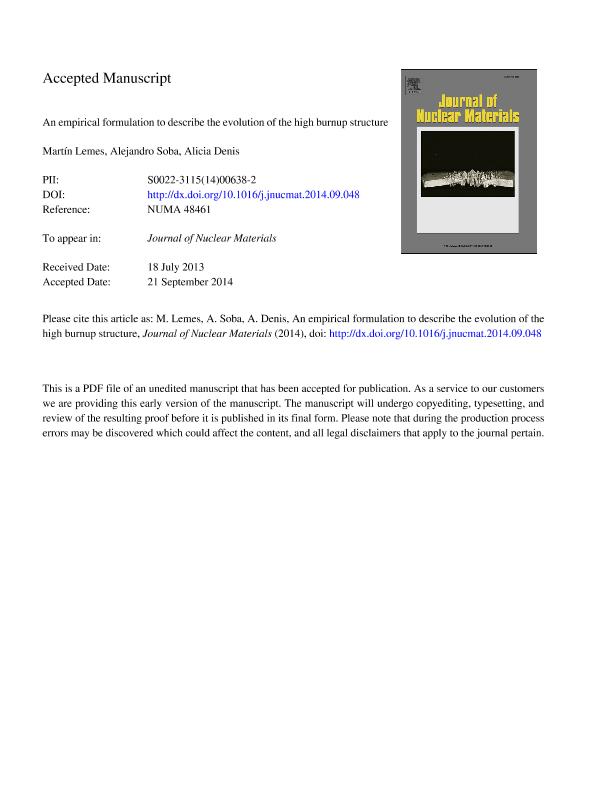Mostrar el registro sencillo del ítem
dc.contributor.author
Lemes, Martín
dc.contributor.author
Soba, Alejandro

dc.contributor.author
Denis, Alicia Catalina

dc.date.available
2017-12-26T20:08:13Z
dc.date.issued
2014-09
dc.identifier.citation
Soba, Alejandro; Lemes, Martín; Denis, Alicia Catalina; An empirical formulation to describe the evolution of the high burnup structure; Elsevier Science; Journal of Nuclear Materials; 456; 9-2014; 174-181
dc.identifier.issn
0022-3115
dc.identifier.uri
http://hdl.handle.net/11336/31593
dc.description.abstract
In the present work the behavior of fuel pellets for LWR power reactors in the high burnup range (average burnup higher than about 45 MWd/kgU) is analyzed. For extended irradiation periods, a considerable Pu concentration is reached in the pellet periphery (rim zone), that contributes to local burnup. Gradually, a new microstructure develops in that ring, characterized by small grains and large pores as compared with those of the original material. In this region Xe is absent from the solid lattice (although it continues to be dissolved in the rest of the pellet). The porous microstructure in the pellet edge causes local changes in the mechanical and thermal properties, thus affecting the overall fuel behaviour. It is generally accepted that the evolution of porosity in the high burnup structure (HBS) is determinant of the retention capacity of the fission gases rejected from the fuel matrix. This is the reason why, during the latest years a considerable effort has been devoted to characterizing the parameters that influence porosity. Although the mechanisms governing the microstructural transformation have not been completely elucidated yet, some empirical expressions can be given, and this is the intention of the present work, for representing the main physical parameters. Starting from several works published in the open literature, some mathematical expressions were developed to describe the behaviour and progress of porosity at local burnup values ranging from 60 to 2 300 MWd/kgU. The analysis includes the interactions of different orders between pores, the growth of the pore radius by capturing vacancies, the evolution of porosity, pore number density and overpressure within the closed pores, the inventory of fission gas dissolved in the matrix and retained in the pores. The model is mathematically expressed by a system of non-linear differential equations. In the present work, results of this calculation scheme are compared with experimental data available in the open literature and with simulations performed by other authors. The results of these separate tests are quite satisfactory so, the next step will be the incorporation of this model as a new subroutine of the DIONISIO code, to expand the application range of this general fuel behaviour simulation tool.
dc.format
application/pdf
dc.language.iso
eng
dc.publisher
Elsevier Science

dc.rights
info:eu-repo/semantics/openAccess
dc.rights.uri
https://creativecommons.org/licenses/by-nc-sa/2.5/ar/
dc.subject
Nuclear Fuel
dc.subject
High Burnup
dc.subject
Porosity
dc.subject
Structure
dc.subject.classification
Astronomía

dc.subject.classification
Ciencias Físicas

dc.subject.classification
CIENCIAS NATURALES Y EXACTAS

dc.title
An empirical formulation to describe the evolution of the high burnup structure
dc.type
info:eu-repo/semantics/article
dc.type
info:ar-repo/semantics/artículo
dc.type
info:eu-repo/semantics/publishedVersion
dc.date.updated
2017-12-11T15:02:57Z
dc.journal.volume
456
dc.journal.pagination
174-181
dc.journal.pais
Países Bajos

dc.journal.ciudad
Amsterdam
dc.description.fil
Fil: Lemes, Martín. Comisión Nacional de Energía Atómica; Argentina
dc.description.fil
Fil: Soba, Alejandro. Comisión Nacional de Energía Atómica; Argentina. Consejo Nacional de Investigaciones Científicas y Técnicas; Argentina
dc.description.fil
Fil: Denis, Alicia Catalina. Comisión Nacional de Energía Atómica; Argentina
dc.journal.title
Journal of Nuclear Materials

dc.relation.alternativeid
info:eu-repo/semantics/altIdentifier/url/http://www.sciencedirect.com/science/article/pii/S0022311514006382
dc.relation.alternativeid
info:eu-repo/semantics/altIdentifier/doi/https://doi.org/10.1016/j.jnucmat.2014.09.048
Archivos asociados
